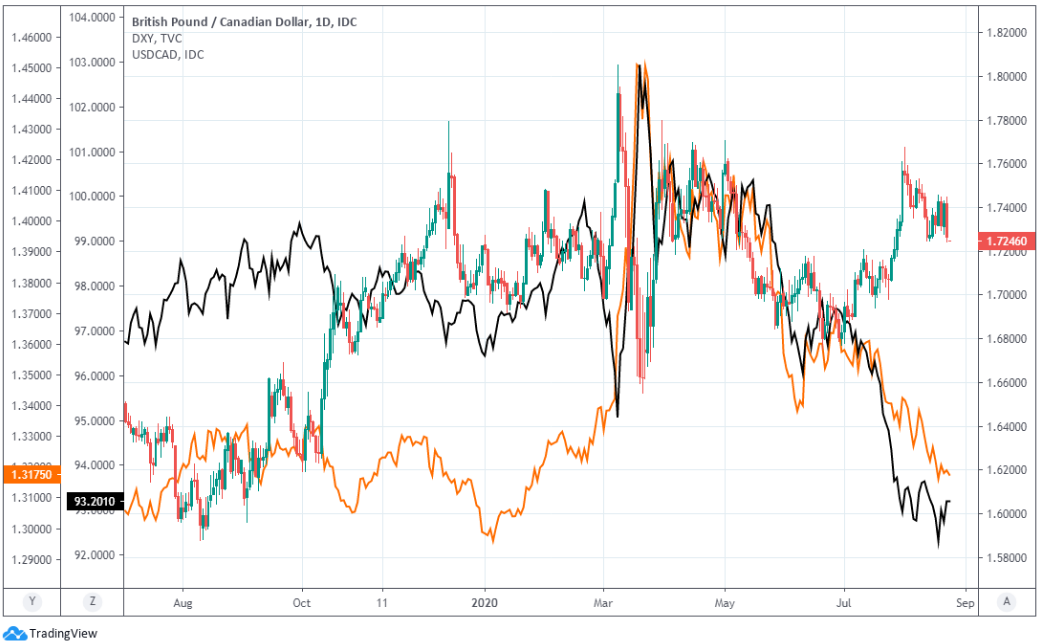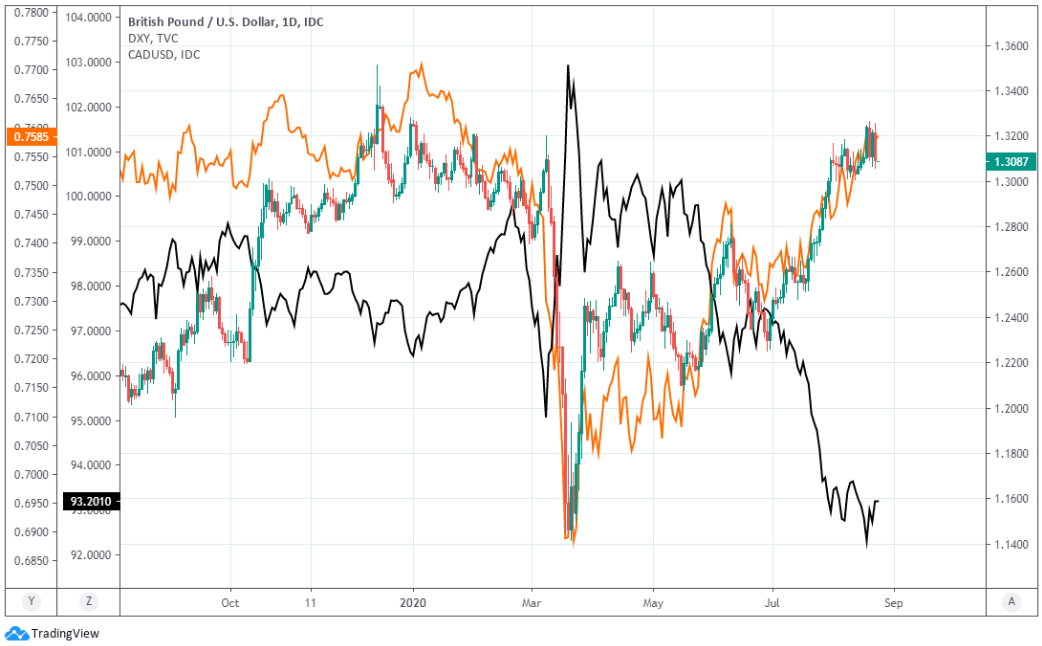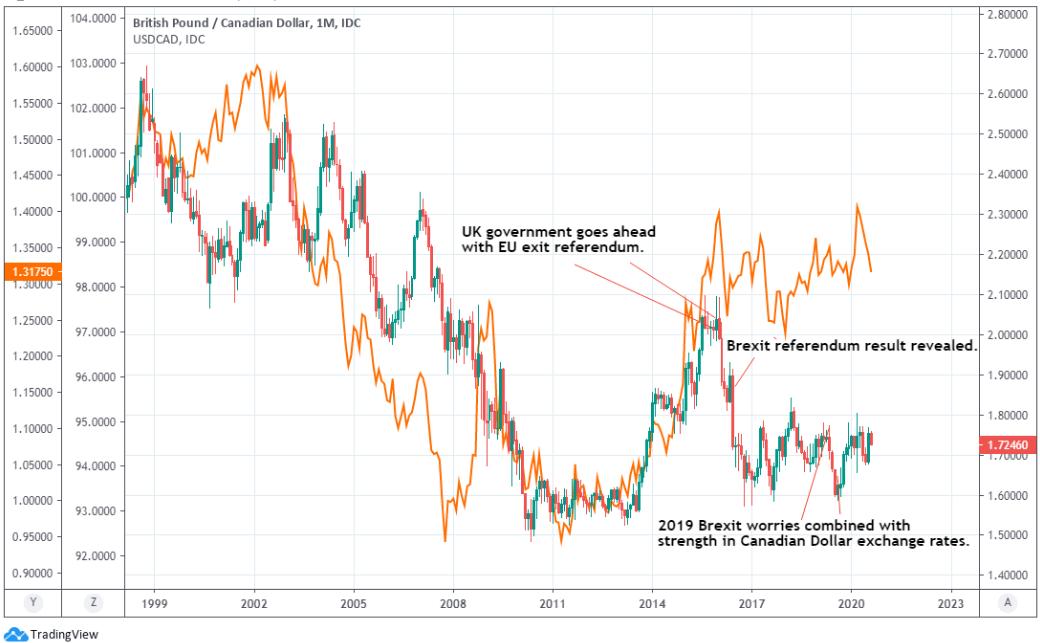Pound-Canadian Dollar Week Ahead Forecast: Supported at 1.7245, Central Bank Speakers Take to the Stage
- Written by: James Skinner
-
- GBP/CAD may be trapped in 1.70-to-1.7438 range short-term.
- Pending a break of correlations between CAD, USD and GBP.
- USD seen steadying as CA GDP, central bank speeches eyed.

File image of the Bank of Canada Governor Tiff Macklem. Image © Bank of Canada. Reproduced Under CC Licensing.
- GBP/CAD spot rate at time of writing: 1.7244
- Bank transfer rate (indicative guide): 1.6640-1.6760
- FX specialist providers (indicative guide): 1.6858-1.7090
- More information on FX specialist rates here
The Pound-to-Canadian Dollar exchange rate suffered heavy losses at the end of an otherwise uneventful week on Friday, but risks becoming trapped in a tight range in the days ahead as Sterling and the Loonie appear to be reacting to current market trends in a similar fashion.
Pound Sterling ended third placed in the performance rankings among major currencies last week after ceding ground to only the Japanese Yen and Canadian Dollar while clocking up an almost-half percent gain over the Dollar.
The Pound-to-Canadian Dollar rate closed around half a percent lower after falling more than one percent on Friday when a downbeat update from Brexit negotiators saw Sterling overtake others in a broad retreat from the U.S. Dollar.
Fresh complaints of deadlock in trade talks with the EU took the wind out of Sterling's sails after PMI data had earlier lifted the currency after they showed a stronger than expected recovery in the UK economy during August.
GBP/CAD losses were compounded by a strong Canadian retail sales report that enabled the Loonie to rise with the closely-correlated Dollar Index, as EUR/USD and GBP/USD tumbled throughout the session.
"Our week-ahead model suggests modest upside risks for USD/CAD towards 1.3245/50 within a broad range of 1.3060/1.3440. We still think there is fundamental value in the CAD near the low/mid 1.33 area currently and would view moderate USD gains as a USD selling opportunity still," says Shaun Osborne, chief FX strategist at Scotiabank.
Above: GBP/CAD at daily intervals with USD/CAD (orange line, left axis) & Dollar Index (black line, left axis).
Sterling and the Loonie were among the last to participate in a major currency advance on the U.S. Dollar and have not been able to reclaim as much previously lost ground as other counterparts have.
That could make the two relative outperformers in the event the U.S. Dollar corrects higher following two months of heavy selling, as a long line of analysts anticipate that it could do in the week ahead which, for the Pound-to-Canadian Dollar rate, would imply sideways movement within a relatively narrow range.
"Short-term bear pressure on the USD is abating and additional gains through the 1.3230/35 area could put the USD on track to test strong, weekly downtrend resistance (1.3345 currently) in the coming week," Osborne writes in a Friday research note. "The broader downtrend remains well-entrenched on the charts, as reflected in the moving average crossover model chart above. We are therefore doubtful that USD rallies can extend too far at present
A similar pattern of price action has gripped the Pound-to-Australian Dollar exchange rate during August and in that case has a lot to do with relatively tight correlations between GBP/USD, EUR/USD and AUD/USD, which have reached 2020 and multi-year highs respectively in recent weeks.
"The GBP looks to have found good support at 1.7245 via a bullish “morning star” signal on the daily candle chart but we think a move above 1.7375 (minor trend channel, possible bull flag) is needed to lift the cross," says Juan Manuel Herrera, a Scotiabank colleague of Osborne's, in a Tuesday note.
If the USD/CAD rate heads up to 1.3440 and the top of Scotiabank's envisaged range for the week at the same time as GBP/USD retreats back toward 1.2815, the Pound-to-Canadian Dollar rate would be found trading at 1.7224 and just below its Sunday opening level of 1.7250.
Meanwhile, if GBP/USD returned to recent highs at 1.3265 and USD/CAD recent lows near 1.3150 then GBP/CAD would be quoted somewhere in the region of 1.7438.
But if Canadian Dollar resilience leads USD/CAD to lag other U.S. rates, or if technical resistance bars its path above 1.3250 while GBP/USD turns lower, GBP/CAD would be at risk of a fall to 1.6980.
"CAD continues to prove a more attractive option than AUD and NZD, largely thanks to WTI’s broad resilience and also thanks to a somewhat less worrying contagion situation in the US. Next week, Canadian growth numbers for July will be watched," says Francesco Pesole, a strategist at ING.
Above: GBP/USD at daily intervals with CAD/USD (orange line, left axis) & Dollar Index (black line, left axis).
"As long as the downside remains limited for oil – should still be more resilient than most of its procyclical peers to swings in risk sentiment. It will also be interesting to follow BoC Governor Macklem’s speech," Pesole says.
The U.S. Dollar is oversold and due a correction while the Euro is seen as vulnerable to a retracement lower, especially after French and Eurozone PMI surveys slumped on Friday in a market disappointment that proved pivotal to the trajectory of the major currencies into the weekend.
A quiet economic calendar could mean the gloom kicked up by this data hangs in the air early this week, enabling the Dollar Index to carve out a short-term bottom after two months of losses. The Loonie underperformed with its larger North American cousin and conversely, could now outperform as it corrects higher, leading to a USD/CAD rate that either declines modestly or simply rises at a lesser pace than other U.S. exchange rates this week.
Above: Pound-to-Canadian Dollar rate at monthly intervals with USD/CAD (orange line, left axis).
"The USD sell-off of late looks excessive and some correction stronger appears warranted. But we’d expect any strength to be modest and short-lived given the risks on the horizon including the potential for US equity market under-performance," says Lee Hardman, a currency analyst at MUFG. "The outperformance of the US equity markets has been primarily down to ‘big tech’ and we see increasing risks of the equity market outperformance reversing which we believe is ultimately a negative for the US dollar."
Canada's calendar is dominated by an adress by Carolyn A. Wilkins, Senior Deputy Governor of the Bank of Canada, due on Wednesday, followed by Macklem's adress on Thursday.
Friday sees GDP data for June released at 13:30 BST.
"There is little doubt that the Canadian GDP report will show a gut-churning decline in activity in Q2, but the initial rebound has also been eye-catching. And early indicators for the US economy in Q3 have also looked less-bad than feared, despite the resurgence of COVID-19 infections," says Nathan Janzen, a senior economist at RBC Capital Markets. "The initial recovery-phase was always expected to look quite sharp as containment measures eased. The pullback in March and April was so large that record increases in Q3 GDP will still leave both the Canadian and US economies operating well-below capacity limits, and further growth will be harder to come by."
"This week’s sparse economic data calendar has a distinct late-August feel. There are a number of releases in the US that may interest markets but elsewhere it seems set to be very quiet. That suggests the focus will remain on coronavirus news and particularly the latest evidence on European trends. Also likely to command attention is the Kansas City Fed’s annual economics symposium, which will include talks from US Fed Chair Powell and Bank of England Governor Bailey," says Rhys Herbert, an economist at Lloyds Bank.
Chairman Powell will speak around 14:10 Thursday at the symposium, while his comments on the Fed's 'framework review' and increasingly "symmetrical" view of the inflation target are a likely focus of the market, and a Dollar-bearish one, the long-term implications of the coronavirus for the bank's monetary policy toolbox may also get a look-in.
"I’m not a central banker, although I would go to Jackson Hole for the trout fishing. Federal Reserve chair Jay Powell speaks on Thursday just a few moments before the US cash equity on Wall Street. Bank of Canada Governor Tiff Macklem follows and Bank of England Governor Andrew Bailey speaks on the Friday. Given the way the minutes of the Fed’s July meeting rocked risk appetite and checked the bulls’ progress, this will offer a chance to catch up on where the Fed one month on with its mid-September FOMC meeting in focus," says Neil Wilson, chief market analyst at Markets.com.
The unprecedented amounts of new money created to fund extraordinary policy supports for the economy could forever have changed the way the Fed combats crises and in a manner that sees future balance sheet expansions working their way more effectively and directly into the real economy.
From corporate bond purchases to government bond buys that are closely coordinated with Treasury fiscal plans, the Fed's new policy bag is a Dollar bearish one and should Powell delve into this subject on Thursday then he might ensure a soft finish to the week for the greenback
The same is true of the BoC and BoE whose governors address audiences at 16:15 on Thursday and 14:05 on Friday respectively. Both currencies will listen for clues on how policy stances may change in the months ahead.








